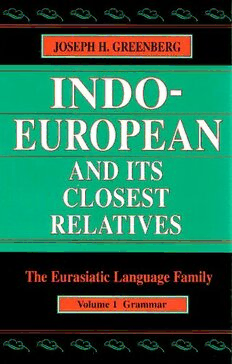
Indo-European and Its Closest Relatives: The Eurasiatic Language Family, Volume 1. Grammar PDF
Preview Indo-European and Its Closest Relatives: The Eurasiatic Language Family, Volume 1. Grammar
JOSEPH H. GREENBERG INYI0L EUROPEAN AND ITS CLOSEST RELATIVES The Eurasiatic Language Family “This is a very important book by a man whose work has been central to discussions of comparative linguistics throughout the second half of the twentieth century. The position of Indo-European among the world’s languages in prehistoric times is one of the two or three cutting-edge issues in historical linguistics today. Greenberg not only presents new material but organizes familiar material in a clear and provocative way, one that will stimulate debate in the popular and scientific press and further research among specialists.” —Carol Justus, University of Texas, Austin Books of Related Interest On Language Selected Writings of Joseph H. Greenberg Edited by Keith Denning and Suzanne Kemmer 1990 Language in the Americas Joseph H. Greenberg 1987 ISBN 0-8047-3812-2 L Stanford University Press WWW.SUp.org a‘h,mm.l Indo-European and Its Closest Relatives Volume 1. Grammar Indo-European and Its Closest Relatives The Eurasiatic Language Family Volume 1. Grammar Joseph H. Greenberg = Stanford University Press Stanford, California 2000 Stanford University Press Stanford, California ©2000 by the Board of Trustees of the Leland Stanford Junior University Printed in the United States of America CIP data appear at the end of the book 1o my wife, Selma Preface The present work is the first volume of a projected two-volume work on the Eurasiatic language family. It is devoted to the grammatical evidence; the second volume will present the lexical items that are, in fact, every whit as extensive and cogent as the grammatical evidence. This grammatical evidence is quite sufficient in itself to estab- lish the validity of the Eurasiatic family. I have chosen to present it first for several reasons. One of these is that in spite of the frequent affirmation of the importance of such evidence, it is almost lacking in present-day attempts to delineate broader and deeper linguistic stocks. The second major reason is that, despite all the facts regard- ing the presentation of evidence for linguistic stocks in my previous work, the myth persists that I only take into account vocabulary evidence. A third reason is the inherent interest and fascination of this type of linguistic evidence in its own right. In particular, gram- matical comparison of related forms in stocks of chronological depth provides rich material for diachronic typological study, both of the earlier stages of grammaticalization and of the later stages of the history of categories. Here typological and genetic studies are mu- tually fruitful. The study of later stages, leading in many instances to functionless survival, lexicalization, and functional reinterpreta- tion, at once informs diachronic typology and leads to the identifica- tion of related forms in only distantly related languages whose basic connection is reinforced by dynamic typological considerations. viii PREFACE In the course of the preparation of this work, which began at least twenty years ago, I accumulated many indebtednesses that I am pleased to acknowledge. First, I should mention the staff of the Green Library Reference section at Stanford, whose helpfulness and willingness to go to extraordinary lengths to excavate from the Stanford library itself, or to procure and often reproduce materials essential to the present study, I acknowledge with profound grati- tude. Of these I first mention the reference librarians proper. I note here only those who were present during a major portion or all of the time I was at work on the present volume. Without exception, the many others, whose names are omitted for practical reasons, were equally cheerful and helpful. | Special gratitude is owed to Richard Fitchen, the director of the Reference section. I should also like to thank, among others, Eric Heath, Barry Hinman, Elisabeth Green, Kathryn Kerns, Rose Adams, and Joanne Hoffman. Especially important was the great service rendered by the Interlibrary Borrowing division, especially Sonia Moss, its head, and Olga Katz. I am especially indebted to John Rawlings, the linguistic and anthropological bibliographer at Green Library, and to Wojciech Zalewski, who expended great effort to obtain, on his collecting trips to Eastern Europe, doctoral dissertations and other materials often very difficult or impossible to obtain in this country. I would also like to express my indebtedness to Norris Pope, the director of Stanford University Press, and Muriel Bell, the editor of the Social Science division, for their help and their facilitation of the publication of the present work. A number of scholars read earlier drafts of particular chapters of this manuscript and made valuable comments and criticism that have been incorporated in the present volume. I mention here es- pecially Vyacheslav Ivanov, Richard Dasher, Carol Justus, Allan Bomhard, and Paul Kiparsky. Finally, I owe a special debt of gratitude to Merritt Ruhlen, who, with his unique combination of gifts, designed and typeset the present volume, provided many critical comments, made the maps, and saw it through the press. J.H.G.
